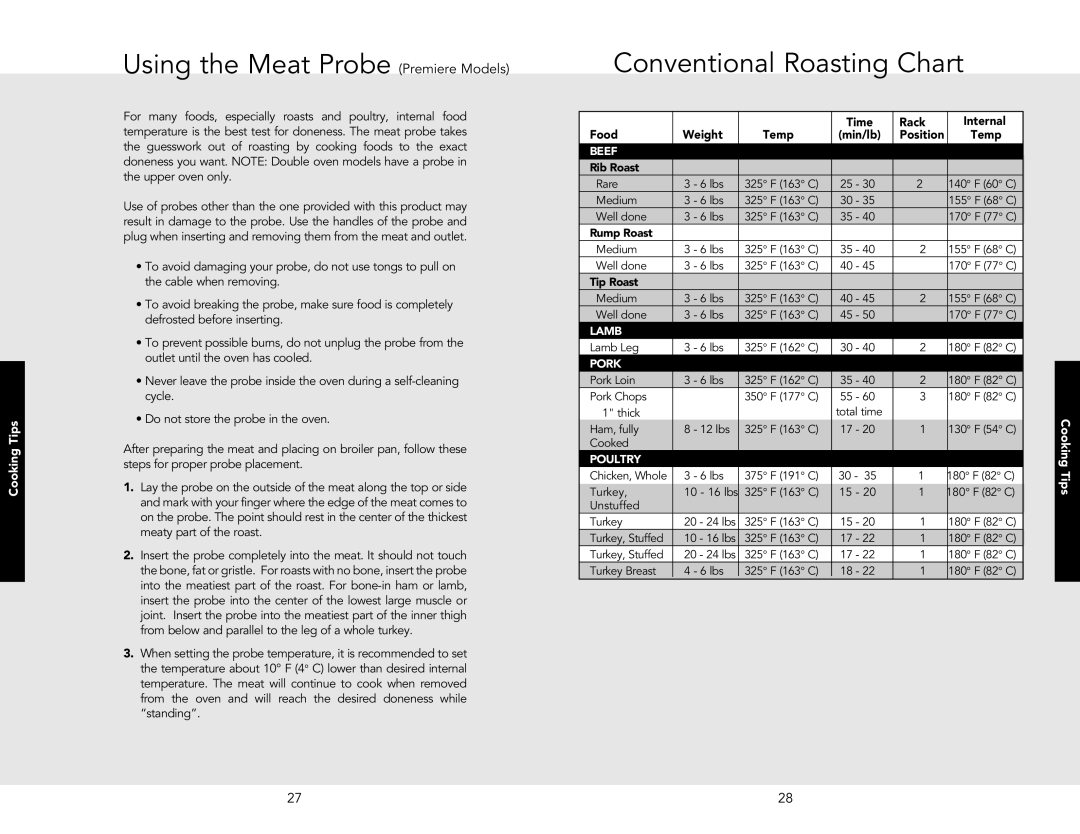
Cooking Tips
Using the Meat Probe (Premiere Models)
For many foods, especially roasts and poultry, internal food temperature is the best test for doneness.The meat probe takes the guesswork out of roasting by cooking foods to the exact doneness you want. NOTE: Double oven models have a probe in the upper oven only.
Use of probes other than the one providedwith this product may result in damage to the probe. Use the handles of the probe and plug when insertingand removingthem from the meat and outlet.
•To avoid damagingyour probe,do not use tongs to pull on the cable when removing.
•To avoid breaking the probe, make sure food is completely defrosted beforeinserting.
•To prevent possible burns,do not unplug the probe from the outlet until the oven has cooled.
•Never leave the probe inside the oven during a
•Do not store the probe in the oven.
After preparing the meat and placingon broiler pan, follow these steps for proper probe placement.
1.Lay the probe on the outside of the meat along the top or side and mark with your fingerwherethe edge of the meat comes to on the probe. The pointshouldrest in the center of the thickest meaty part of the roast.
2.Insert the probe completelyinto the meat. It should not touch the bone,fat or gristle. Forroasts withno bone, insert the probe into the meatiest part of the roast. For
3.When setting the probetemperature,it is recommended to set the temperatureabout 10° F (4° C) lower than desired internal temperature. The meat will continue to cook when removed from the oven and will reach the desired doneness while “standing”.
Conventional Roasting Chart
|
|
|
| Time | Rack | Internal |
|
| |
Food | Weight | Temp | (min/lb) | Position | Temp |
|
| ||
|
|
|
|
|
|
|
|
|
|
BEEF |
|
|
|
|
|
|
|
|
|
|
|
|
|
|
|
|
|
|
|
Rib Roast |
|
|
|
|
|
|
|
|
|
Rare | 3 | - 6 lbs | 325° F (163° C) | 25 | - 30 | 2 | 140° F (60° C) |
|
|
Medium | 3 | - 6 lbs | 325° F (163° C) | 30 | - 35 |
| 155° F (68° C) |
|
|
Well done | 3 | - 6 lbs | 325° F (163° C) | 35 | - 40 |
| 170° F (77° C) |
|
|
Rump Roast |
|
|
|
|
|
|
|
|
|
Medium | 3 | - 6 lbs | 325° F (163° C) | 35 | - 40 | 2 | 155° F (68° C) |
|
|
Well done | 3 | - 6 lbs | 325° F (163° C) | 40 | - 45 |
| 170° F (77° C) |
|
|
Tip Roast |
|
|
|
|
|
|
|
|
|
Medium | 3 | - 6 lbs | 325° F (163° C) | 40 | - 45 | 2 | 155° F (68° C) |
|
|
Well done | 3 | - 6 lbs | 325° F (163° C) | 45 | - 50 |
| 170° F (77° C) |
|
|
LAMB |
|
|
|
|
|
|
|
|
|
Lamb Leg | 3 | - 6 lbs | 325° F (162° C) | 30 | - 40 | 2 | 180° F (82° C) |
|
|
PORK |
|
|
|
|
|
|
|
|
|
|
|
|
|
|
|
|
|
| |
Pork Loin | 3 | - 6 lbs | 325° F (162° C) | 35 | - 40 | 2 | 180° F (82° C) |
|
|
Pork Chops |
|
| 350° F (177° C) | 55 | - 60 | 3 | 180° F (82° C) |
|
|
1" thick |
|
|
| total time |
|
|
| Cooking | |
Ham, fully | 8 | - 12 lbs | 325° F (163° C) | 17 | - 20 | 1 | 130° F (54° C) |
| |
|
| ||||||||
Cooked |
|
|
|
|
|
|
|
|
|
POULTRY |
|
|
|
|
|
|
|
|
|
Chicken, Whole | 3 | - 6 lbs | 375° F (191° C) | 30 - 35 | 1 | 180° F (82° C) |
| Tips | |
Turkey, | 10 - 16 lbs | 325° F (163° C) | 15 | - 20 | 1 | 180° F (82° C) |
| ||
|
| ||||||||
Unstuffed |
|
|
|
|
|
|
|
|
|
Turkey | 20 - 24 lbs | 325° F (163° C) | 15 | - 20 | 1 | 180° F (82° C) |
|
| |
Turkey, Stuffed | 10 - 16 lbs | 325° F (163° C) | 17 | - 22 | 1 | 180° F (82° C) |
|
| |
Turkey, Stuffed | 20 - 24 lbs | 325° F (163° C) | 17 | - 22 | 1 | 180° F (82° C) |
|
| |
Turkey Breast | 4 | - 6 lbs | 325° F (163° C) | 18 | - 22 | 1 | 180° F (82° C) |
|
|
|
|
|
|
|
|
|
|
|
|
27 | 28 |
